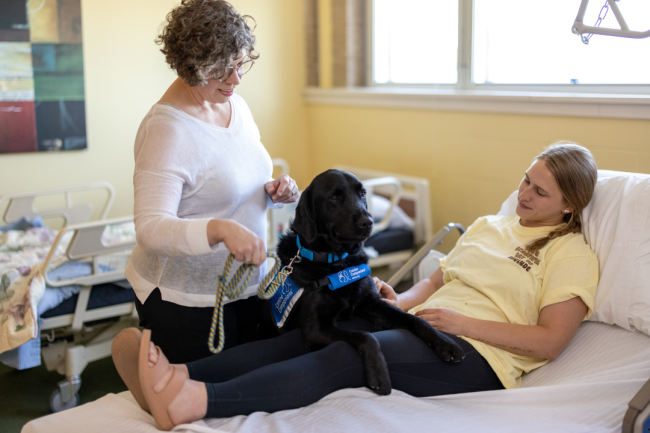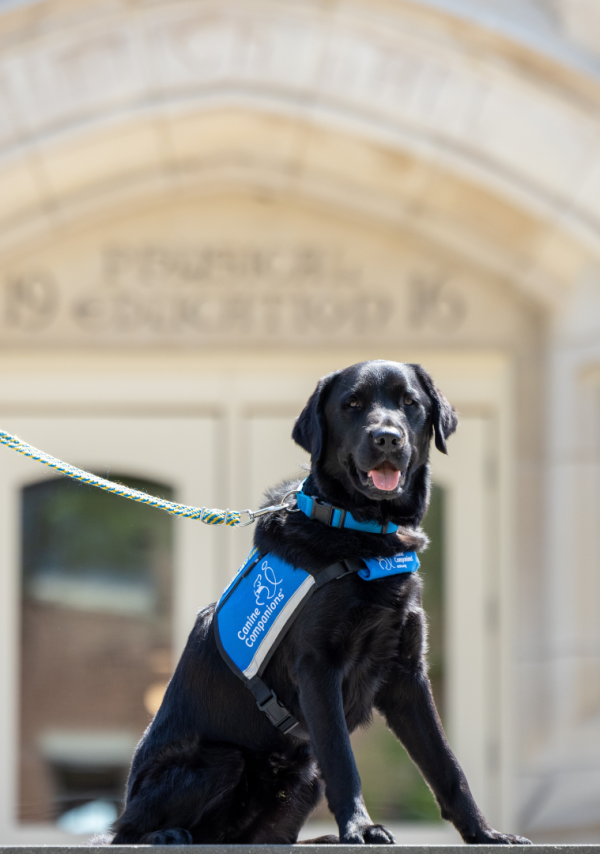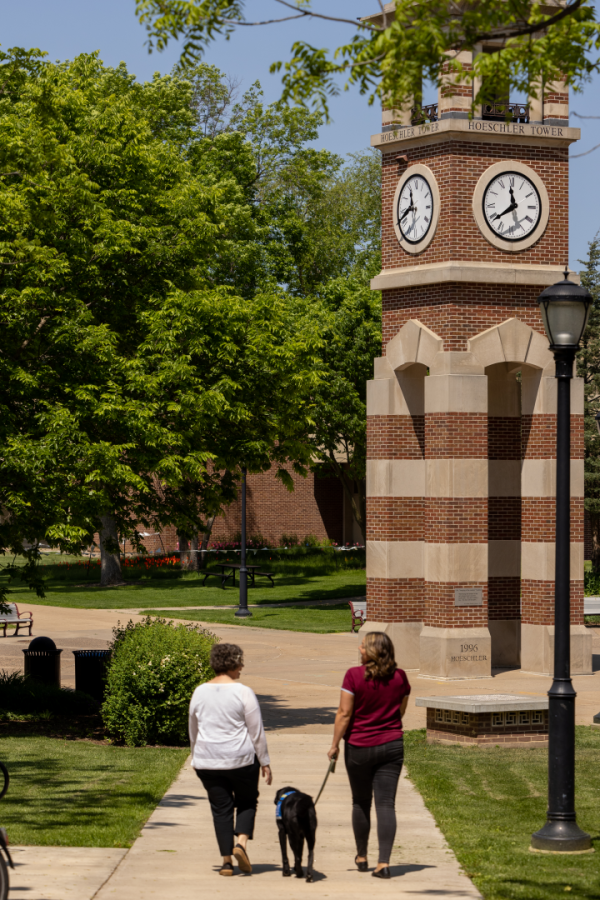You have /5 articles left.
Sign up for a free account or log in.

Rossi, a black Labrador retriever, works alongside two faculty handlers in the applied health sciences division, including in clinical and classroom settings.
University of Wisconsin at La Crosse
The University of Wisconsin at La Crosse’s Health Science Interprofessional Research Center (HSIRC) added a four-legged friend to its cohort this year. Rossi, a black Labrador retriever, started at the university this year as the first facility service dog working in a clinical and classroom setting.
Rossi is one part of Dr. Wags, an animal assisted intervention program that HSIRC launched in May, creating new experiential learning and research opportunities for students and offering community education around the various types of service dogs.
The program has benefited students’ career preparation, increased the institution’s understanding of a facility service dog and added an overall positive force to the campus environment, says Jenn Taylor, assistant professor of recreation management and therapeutic recreation.
What’s the need: HSIRC is a research collaboration between four departments—occupational therapy, physical therapy, recreational therapy and exercise and sports science. Applied health faculty members at UW La Crosse were looking to develop cross-departmental opportunities for student learning and research when they considered adding a facility service dog to campus.
The University of Oklahoma at Tulsa has a similar program, Professor Paws, which provides education to students working in clinical settings, to the general community in Oklahoma and as a campus ambassador.
Across the U.S. and Canada, there are approximately 14,809 working dogs certified by Assistance Dogs International serving as guide dogs, hearing dogs and service dogs. Students looking to start a career in therapy may encounter service dogs in a clinical setting supporting their clients and be unaware of how to engage with the dog. Dr. Wags gives students a chance to learn alongside a dog and provide greater support and guidance to present and future clients.
Rossi is trained in 40 commands to assist people with disabilities or disabling health conditions.
University of Wisconsin-La Crosse
Meet Rossi: Rossi is a facility service dog, which means he works alongside someone in a larger setting (as opposed to a service dog, who supports one person and their disability). Facility service dogs learn 40 commands and can be found in courthouses, schools, counseling centers, hospitals and other treatment settings.
Rossi received training from Canine Companions, which provides trained dogs for free to children, veterans and those with disabilities. Among his abilities, Rossi can pull wagons, open refrigerators, help a person put on a shoe, do laundry and play games like Frisbee and ring toss.
Two professors, Laura Schaffer from the occupational therapy program and Tara DeLong from the recreational therapy program, are trained as Rossi’s handlers. Schaffer and DeLong are the only people who can give Rossi commands, and Rossi goes home with Schaffer or DeLong at the end of his busy day.
During the week, Rossi will work at least 20 hours, five days a week, in the on-campus or community-based clinics hosted by UW La Crosse alongside allied health professions students. If he’s not at the clinic, he’s in the classroom or with his handlers in one of their offices.
A professional pup: To bring Rossi to campus, La Crosse faculty had to work with a variety of stakeholders.
Since he is the first service dog in the UW system, acquiring Rossi required some new processes, including following risk management considerations from the Institutional Animal Care and Use Committee (IACUC), which oversees animal welfare on college campuses, and creating protocol.
UWL professors Tara DeLong, associate teaching professor in recreational therapy (left), and Laura Schaffer, program director for occupational therapy program (right), care for Rossi on and off campus.
University of Wisconsin-La Crosse.
But due to the number of program champions who helped Dr. Wags launch, the center shaved about three years off the estimated approval process.
“No single person could do this—it wouldn’t have worked here at all,” Taylor says. What worked was “having the professors but also having the students that, from the beginning, that were just so passionate about it.”
Faculty at Oklahoma, as well as a friend of Taylor’s who works with facility dogs in a correctional setting, provided key intel to get Dr. Wags off the ground, Taylor adds.
The impact: The student response to Rossi has been overwhelmingly positive, Taylor says. “I was blown away how much students love having Rossi on campus.” She jokes that it takes an hour to cross campus with Rossi, because they’re constantly being stopped so students can pet him or talk about his jobs.
“Undergrad and grad, I think there’s been a great appreciation because they want to work animals into their future jobs as therapists and they didn’t know how to do that,” Taylor explains. “Now, going through the programs, they’re learning care and safety and how to develop protocols and also the risk management part of it.”
Next steps: Faculty hope to scale Dr. Wags to include therapy dogs and socially assisted robots.
Rossi is trained to work with individuals with disabilities or disabling conditions, so while he can work as a comfort animal for a larger group, he’s better served in a classroom or clinical setting. Given the number of students seeking the care of a comfort animal, faculty see a need to add traditional therapy dogs for ongoing campus care, including dorm visits and wellness events.
Socially assisted robots, or robot pets, can help people with social engagement and provide the same benefits as interacting with a live animal, such as decreased blood pressure, Taylor explains. The research is still development, but UW La Crosse has one cat and one dog robot, which staff are in the process of naming and writing curriculum for.
HSIRC staff hope to share additional details of creating an animal-assisted intervention program with colleagues through journal publication and conference appearances in the near future.
“We are an open book,” Taylor says. “So we will share any policy that we’re allowed to share, which is all of them, basically.”
If your student success program has a unique feature or twist, we’d like to know about it. Click here to submit.






